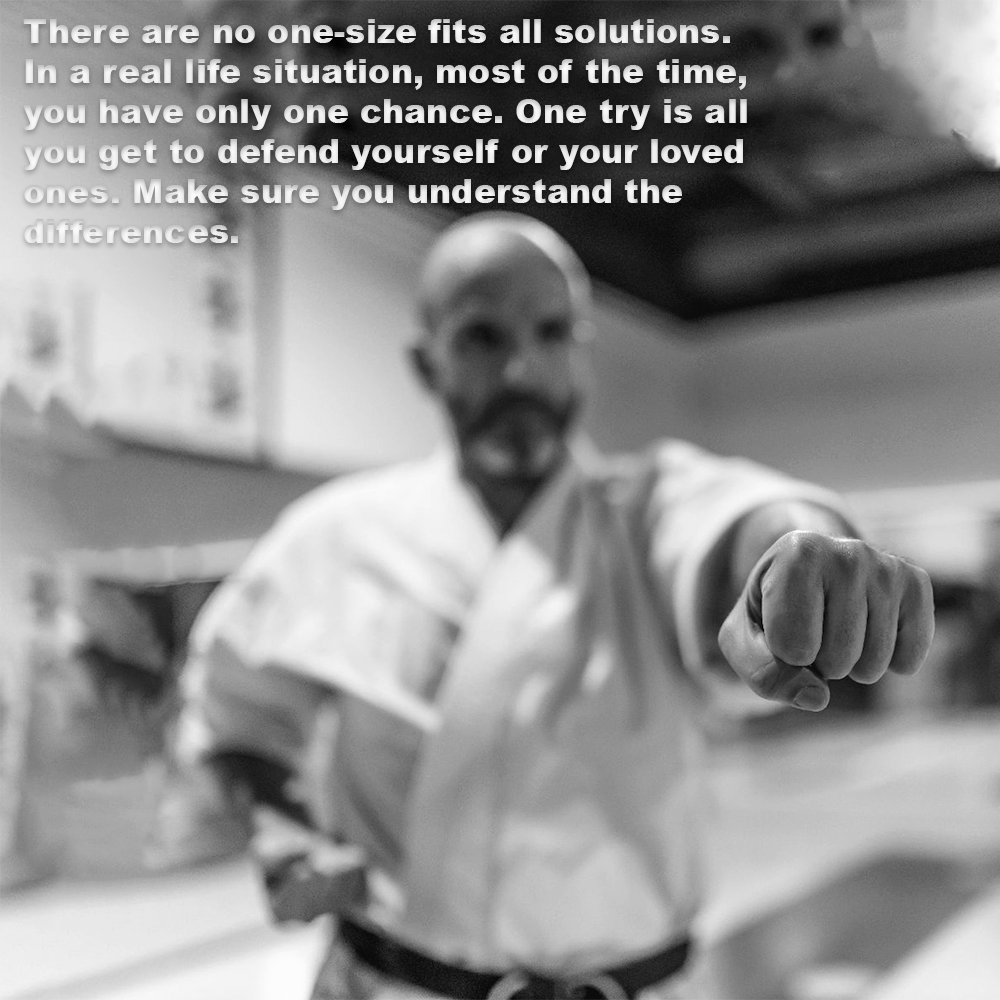
In a real life situation, most of the time, you have only one chance. One try is all you get to defend yourself or your loved ones.
Posted by ADAM CARTER on JUL 25, 2023

In a real life situation, most of the time, you have only one chance. One try is all you get to defend yourself or your loved ones.
What constitutes as personal protection today falls outside the scope of most martial arts classes. Irrespective of whether you think your martial art is perfect for the “street” (whatever that means) or not. Most martial arts only deal with the fighting aspect of personal protection.
In most cases, the student is actually only learning how to fight with another person from the same style….. fun, but very different from a no-rules, all-out, altercation in the real world.
Competition, sparring, ‘kumite’ can be great fun, but the skills you develop has few crossover skills for personal protection.
For example, going to the ground may be tactically good in the sporting context, but is never the place you should choose to be in a real-world environment.
Most importantly the mindset is different.
When sparring in the dojo, if I dominated my opponent 100%, every time, all the time, it would cease to be challenging. We want a back-and-forth contest so both of us can learn and develop.
However, with personal protection we need to seize the initiative and dominate our attacker until we can safely escape. And ESCAPE is the priority.
This is where most martial artists get it wrong. All they consider is fighting.
Non-consensual violence accounts for just a small percentage of any personal protection system. A good personal protection system must consist of awareness, avoidance, de-escalation, and escape skills too. Much of which is only paid lip service, with instruction such as, “run away if you can.”
Lip service is also paid to avoidance and awareness. Avoid what? Be aware of what? Here again danger signs and warning signs need to be understood to help a student manage a real situation.
Understanding preemptive strikes, use of the ‘fence’, and the legal ramifications of your actions. Legal issues in particular, generally fall outside your traditional martial arts class. Of course you cannot know the legalities for every country, state or area, but there are simple rules everyone can follow.
Another failing of many martial arts is the type of attack scenarios that they train. Karate lunge punches from outside touching distance with the attacker leaving the attacking limb extended, or freezing in one place. The fact that these drills are pre-arranged with a non-resisting partner attacking from the wrong range, limits their effectiveness.
Pressure testing your techniques should be taught. Constant drilling in line, punching and kicking the air, does not give the student effective feedback on the technique. Restrictive punching, ranges and positions, should all be practiced on some form of impact training device.
So called “dirty” techniques get their name from being banned in sporting competitions. Many of these techniques work perfectly well in personal protection and should be considered part of your practice.
The bad guys don’t want to fight, they’re not in it to lose. They use surprise or blitz attacks. Martial arts work well where you have time and choices. Unscripted violence comes as a surprise, and you will be surprised, don’t kid yourself that you won’t, especially if you’re awareness skills have failed you.
You should be training for when things go wrong, having a default position when you don’t know what to do. So, when you are taken by surprise, you have something to fall back on.
Personal protection is not primarily a physical skill, it’s an emotional skill, it’s about how fast you can recover when injured or surprised. What to do is almost never the problem. Overcoming freezing in place can be an issue.
There are generations of students and instructors who believe what they do is real, and they are prepared for the “street”. Many martial artists who teach fighting first need to reconsider the way they teach their students self-defense, because virtually all that is taught today is based upon the modern interpretation of karate, overly ritualized, and rule-bound with completely unrealistic applications being passed off as, “practical self-defense techniques”.
There are no one-size fits all solutions. In a real life situation, most of the time, you have only one chance. One try is all you get to defend yourself or your loved ones. Make sure you understand the differences.
